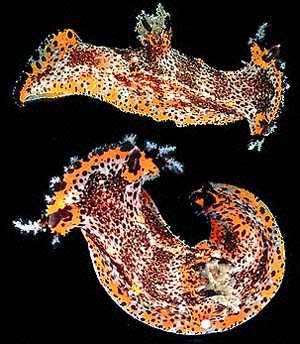
Plocamopherus tilesii
Bergh, 1877
Order: NUDIBRANCHIA
Suborder: DORIDINA
Family: Polyceridae
Subfamily: Triophinae
DISTRIBUTION
Known from Japan and China. Also reported occasionally from New South Wales, although no published records.
PHOTO
Plocamopherus tilesii, Nelson Bay, Port Stephens, March 1988.
Photos: Bill Rudman
RELATED TOPIC
Reference:
• Bergh, L.S.R. (1877). Malacologische Untersuchungen. In: C.G. Semper, Reisen im Archipel der Philippinen, Wissenschaftliche Resultate. Band 2, Heft 11: 429-494, Pls. 54-57.
Rudman, W.B., 1998 (February 2) Plocamopherus tilesii Bergh, 1877. [In] Sea Slug Forum. Australian Museum, Sydney. Available from http://www.seaslugforum.net/find/ploctile
Related messages
Plocamopherus tilesii from Queensland
November 12, 2002
From: Nigel Holmes
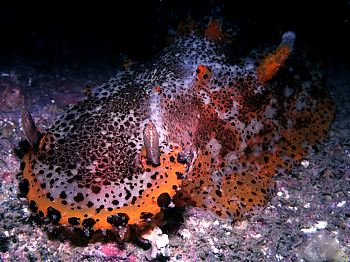
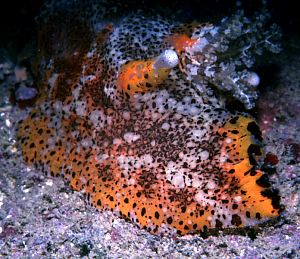
Bill
Recently my wife Jacquie found a Plocamopherus tilesii in the reef flat shallows of North Keppel Island on a rising tide.
My photos using a 2:1 macro framer are attached. The P. tilesii was very reluctant to cling on to anything and was intent on slowly swimming well above the bottom using its large flat tail [lower photo]. The broad flat head [upper photo] seems to be used for altitude control, it being tipped back at 45 degrees until it reached about 0.5m above the bottom when it settled into a flatter posture and continued swimming.
Regards
Nigel Holmes
Rockhampton, Queensland.
holmesnjc@optusnet.com.au
Holmes, N., 2002 (Nov 12) Plocamopherus tilesii from Queensland. [Message in] Sea Slug Forum. Australian Museum, Sydney. Available from http://www.seaslugforum.net/find/8375Dear Nigel,
Thanks for these photos. This grows into quite a large animal but we know very little about its biology. Bill Chambers' message reporting it to be a burrower, suggests it may be another of these soft-bottom dwelling nudibranchs with an enlarged oral veil, or its equivalent, which can be used to sense food in the sediment. Other related species are bryozoan feeders but I have no idea what this one feeds on.
Best wishes,
Bill Rudman
Plocamopherus tilesi or tilesii
July 5, 1999
From: Wayne Ellis
Hi Bill,
Is it P. tilesi or tilesii. Both spellings occur on your site.
Wayne
glaskin@ozemail.com.au
Dear Wayne,
Thanks for keeping me honest. Checking the original spelling and later literature, tilesii is correct. My only excuse is I used Russell's very useful Index Nudibranchia to check my spelling when I was preparing the webpage and as luck would have it, this is one of Russell's few errors. I have corrected all my mispellings on the site.
Cheers,
Bill Rudman.
Plocamopherus tilesii from Port Stephens, NSW
June 29, 1999
From: Grey McNeil
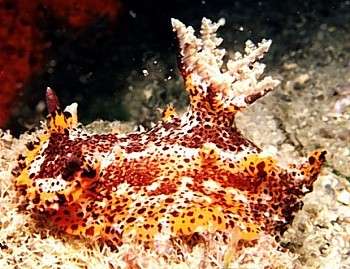
Dear Bill,
Could you identify this photo please. The details are:
PIPELINE, NELSON BAY, Port Stephens, NSW. eastern Australia. 8m, May 1998, 7cm long.
Thanks,
Grey McNeil.
GREYMACIND@bigpond.com
McNeil, G., 1999 (Jun 29) Plocamopherus tilesii from Port Stephens, NSW. [Message in] Sea Slug Forum. Australian Museum, Sydney. Available from http://www.seaslugforum.net/find/998Dear Grey,
This is Plocamopherus tilesii which is not uncommon in eastern Australia. Have a look at the photos at the Top of This Page and my comments on an earlier message.
Bill Rudman.
Rudman, W.B., 1999 (Jun 29). Comment on Plocamopherus tilesii from Port Stephens, NSW by Grey McNeil. [Message in] Sea Slug Forum. Australian Museum, Sydney. Available from http://www.seaslugforum.net/find/998Nudi burying itself
February 2, 1998
From: Bill Chambers
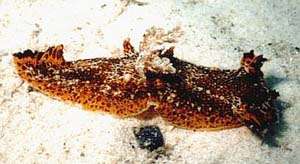
Concerning the web-page, I wish you well, and hope that it will be a resounding success! Thanks for the effort!
Attached is a TIF file of another Nudi taken at Little Beach, Nelson Bay, Port Stephens, NSW on 01FEB98. The depth was 5m over a sandy bottom. The unusual thing (for me) about this Nudi is that it was in the process of burying itself under the substrate when first observed. It was actually flicked out of the sand with a finger prior to it's recovery and the resulting photo. I have another shot of it partially buried & bent double.
Once again thanks for your time!
Warm Regards,
Bill Chambers.
This is Plocamopherus tilesii. Species of Plocamopherus have a number of interesting features. They have paired 'appendages' down each side of the body some of which end in a large rounded knob. At least in Plocamopherus imperialis and P. ceylonicus these knobs can flash a bright luminescent light when disturbed. These animals can also turn the back end of the body into a high flattened paddle which is useful in helping the slug swim through the water with vigorous side to side movement of the body. They feed on bryozoans. Your observation on them burrowing is very interesting and I have no recollection of it being reported before. It is interesting that this species has a very wide foot which is found in other burrowing slugs such as the aeolid Cerberilla. Any other reports of burrowing or unusual behaviour would be very welcome... Bill Rudman
Rudman, W.B., 1998 (Feb 2). Comment on Nudi burying itself by Bill Chambers. [Message in] Sea Slug Forum. Australian Museum, Sydney. Available from http://www.seaslugforum.net/find/119